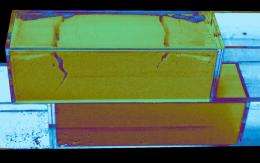June 12, 2012 report
Rutgers granular-slip study documents voltage signals (w/ Video)

(Phys.org) -- A voltage signal preceding failure of bridges and other structures made of powder has been documented by three researchers in the Department of Biomedical Engineering at Rutgers University. Their findings, published on Monday in Proceedings of the National Academy of Sciences, are an important step forward.
The authors note that “it has been known for over a century that electrical signals are produced by material failure, for example during crack formation of crystals and glasses, or stick-slip motion of liquid mercury on glass.”
They say that slip events in cohesive powders also produce electrical signals, and that these signals can appear significantly in advance of slip events. Key structural materials—ceramics in turbines, chalk in cliffs, and concrete in bridges—are made from powders; a voltage spike might precede cracking in these structures.
The authors of the paper, ”Electrostatic precursors to granular slip events,” are Troy Shinbrot, Nam H. Kim, and Nirmal Thyagu, and they discuss their results from lab tests on powders. They documented a voltage signal. They studied how clumps of fine particles emit electrical voltages just before they crack. Pulling powders apart seems to produce a voltage.
Shinbrot and his study team studied scoops of finely ground Tylenol in a slowly-spinning cylinder. Powder stuck to the sides, built up, and after reaching a certain height, cracked and tumbled down to the bottom. The “mini avalanches" created voltages higher than 100 volts. They discovered that the voltage spike sometimes preceded the avalanche by as much as five seconds.
Outside of Rutgers, a doctoral candidate familiar with the electrification of granular systems noted that five seconds might not be meaningful to save people from an earthquake area but would be beneficial in a smart-grid setting in turning off technologies that might cause explosions or fires during a quake.
The researchers at Rutgers performed several experiments before reaching their conclusions; they used different containers and different powders. Bleached and unbleached flour, plaster and mortar were tried and the team found the same results. Similar voltage signals are produced by crack-like defects in several powdered materials.
Failure of these materials, in turn, may be preceded by telltale electrical signals. They speculate that similar voltage changes could be warning signs of internal defects or of impending catastrophic failures in objects made of consolidated powders.
The authors acknowledge that electrical disturbances have been reported in the past to precede major earthquakes and rockbursts, but many of these reports have been anecdotal. At the same time, a growing body of field measurements will help other research efforts to more fully understand these events. “We anticipate that the ability to generate correlated electrical signals and slip events in a controlled setting will enable future research to unveil the mechanisms leading to the curious effects.”
Prof. Shinbrot says a better understanding of the particles' electrical interactions may enable technologies that predict breakages before they cause catastrophic damage.
More information: Electrostatic precursors to granular slip events, PNAS, Published online before print June 11, 2012, doi: 10.1073/pnas.1121596109
Abstract
It has been known for over a century that electrical signals are produced by material failure, for example during crack formation of crystals and glasses, or stick-slip motion of liquid mercury on glass. We describe here new experiments revealing that slip events in cohesive powders also produce electrical signals, and remarkably these signals can appear significantly in advance of slip events. We have confirmed this effect in two different experimental systems and using two common powdered materials, and in a third experiment we have demonstrated that similar voltage signals are produced by crack-like defects in several powdered materials.
Journal information: Proceedings of the National Academy of Sciences
© 2012 Phys.Org




















